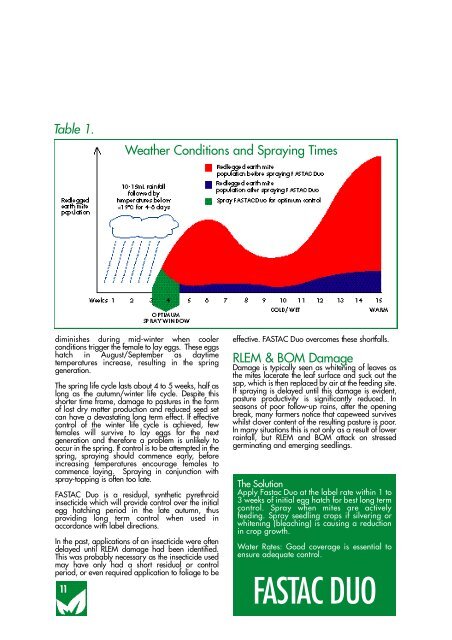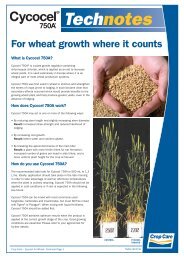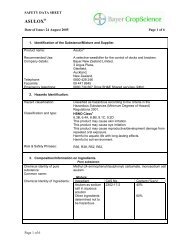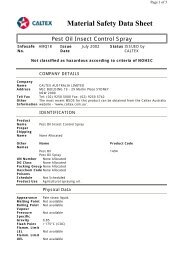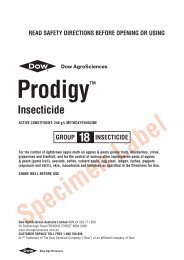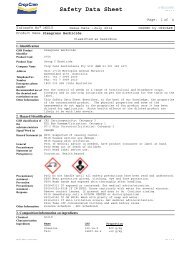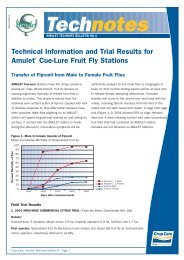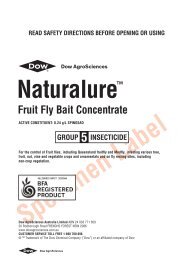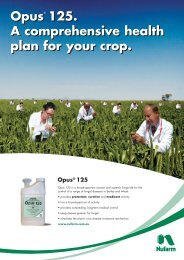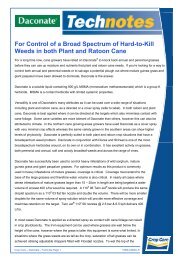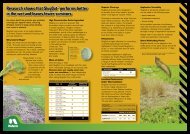Fastac Duo Technical Manual - Pest Genie
Fastac Duo Technical Manual - Pest Genie
Fastac Duo Technical Manual - Pest Genie
Create successful ePaper yourself
Turn your PDF publications into a flip-book with our unique Google optimized e-Paper software.
Table 1.<br />
Weather Conditions and Spraying Ti m e s<br />
diminishes during mid-winter when cooler<br />
conditions trigger the female to lay eggs. These eggs<br />
hatch in August/September as daytime<br />
temperatures increase, resulting in the spring<br />
g e n e r a t i o n .<br />
The spring life cycle lasts about 4 to 5 weeks, half as<br />
long as the autumn/winter life cycle. Despite this<br />
s h o rter time frame, damage to pastures in the form<br />
of lost dry matter production and reduced seed set<br />
can have a devastating long term effect. If eff e c t i v e<br />
control of the winter life cycle is achieved, few<br />
females will survive to lay eggs for the next<br />
generation and therefore a problem is unlikely to<br />
occur in the spring. If control is to be attempted in the<br />
spring, spraying should commence early, before<br />
increasing temperatures encourage females to<br />
commence laying. Spraying in conjunction with<br />
spray-topping is often too late.<br />
FA S TAC <strong>Duo</strong> is a residual, synthetic pyrethroid<br />
insecticide which will provide control over the initial<br />
egg hatching period in the late autumn, thus<br />
providing long term control when used in<br />
accordance with label directions.<br />
In the past, applications of an insecticide were often<br />
delayed until RLEM damage had been identified.<br />
This was probably necessary as the insecticide used<br />
may have only had a short residual or control<br />
period, or even required application to foliage to be<br />
1 1<br />
e ffective. FA S TAC <strong>Duo</strong> overcomes these short f a l l s .<br />
RLEM & BOM Damage<br />
Damage is typically seen as whitening of leaves as<br />
the mites lacerate the leaf surface and suck out the<br />
sap, which is then replaced by air at the feeding site.<br />
If spraying is delayed until this damage is evident,<br />
pasture productivity is significantly reduced. In<br />
seasons of poor follow-up rains, after the opening<br />
break, many farmers notice that capeweed surv i v e s<br />
whilst clover content of the resulting pasture is poor.<br />
In many situations this is not only as a result of lower<br />
rainfall, but RLEM and BOM attack on stressed<br />
g e rminating and emerging seedlings.<br />
The Solution<br />
Apply <strong>Fastac</strong> <strong>Duo</strong> at the label rate within 1 to<br />
3 weeks of initial egg hatch for best long term<br />
control. Spray when mites are actively<br />
feeding. Spray seedling crops if silvering or<br />
whitening (bleaching) is causing a reduction<br />
in crop growth.<br />
Water Rates: Good coverage is essential to<br />
ensure adequate control.<br />
FA S TAC DUO


